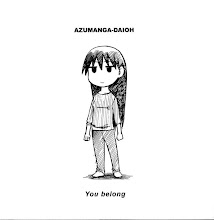One of my all time favorite genre's is the raucous styling of gag manga. Largely joke driven instead of plot driven, many times yonkoma formatting and just indecipherable for those not in the know. Many times the artwork is crude, either to enhance the absurdist nature of whats being presented or because the author is a far better jokester than artist. Out of all of the genres of manga or anime that see distribution in North America, it may be one of the hardest types to sell, perhaps similar to the difficulty of sports stories to gain traction.
There are some well regarded titles that sit firmly in the gag camp, Gintama, Nichijou, Lucky Star, etc. Yet the titles generally have a hard time finding large audiences especially with audiences that are looking for something familiar and/or story driven. I have long been a fan of the genre, eagerly seeking out the bizarre titles that no licensing firm would ever contemplate bringing to America. Titles like the fantastic Gag Manga Biyori or Super Radical Gag Family. America has its own history of absurdist humor and what amounts to sketch comedy. Its not difficult to make connections between Saturday Night Live and Gag Manga Biyori. They both deliver short, self contained concepts who's sole intent is to deliver a punchline. Some gag manga is difficult for Westerners to approach because of the localized nature of the comedy. This can be especially hard when the comedy is styled on the manzai form of stand up.
I had initially started to write about my love for gag manga ten years ago and just sat on a partial script until finally scrapping it. The week of this writing the Netflix exclusive American cartoon inspired by the card game Exploding Kittens premiered and I watched a few episodes of it. I enjoyed it at first but then noticed a common pattern in American adult animation. The need for the writers to force a plot in a single episode as a weak support system for the jokes that are the real focus of the writting. What I enjoyed with the Exploding Kitten cartoon was the absurdist cringe humor peppered through out. Unfortunately the bulk of each episode was consumed with trying to develop an unnecessary narrative that was both contained in the episode and could be expanded across a larger story. I believe the product would have been far more satisfying to both the audience and I suspect the writing staff if it compartmentalized its self focusing on the jokes as the most important, in the way Robot Chicken does.
Even the original source material, The Oatmeal, is self contained jokes and musing with zero over all plot of connectivity. Yet the choice was made to follow the formula used in all manner of adult cartoons designed for Adult Swim and it turned into something that was an imitation of those other show sprinkling with some amusing biting commentary. It could have been some much more if it hadn't fallen victim to forced expectations instead of relying purely on the strength of the joke writing. I have a similar opinion on the Deadpool and Guardians of the Galaxy films. Both of those series have no need for a structured plot as the joy of the movies is the absurd interactions between the characters. Trying to force in a grander story or message only gets in the way of the joy.
Gag manga is a hard sell, even if there are a number of well received titles that have found homes in North America. It doesn't usually get the attention that other more exciting genres get so large portions of the fan base shy away from something that is so different than they are familiar with. But all it takes is to find that one title that scratches an itch that's never been scratched before to make someone a believer.
In conclusion I think my gravitation towards gag manga and anime was laid down as a young child, growing up on sketch comedy like SNL, Monty Python and SCTV. I'm of the opinion that the greatest comedy movie ever made is The Jerk and its story barely does anything other than to set up all of the jokes. There is so much gag manga out there that is difficult to get into because of how obtuse the jokes are if you're not familiar with the medium, that and some legitimate cultural differences. But honestly, thumb through a copy of Life Lessons With Uramichi-oniisan and tell me you didn't laugh.















